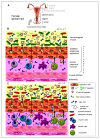Antimicrobial and Prebiotic Activity of Lactoferrin in the Female Reproductive Tract: A Comprehensive Review
- PMID: 34944756
- PMCID: PMC8699013
- DOI: 10.3390/biomedicines9121940
Antimicrobial and Prebiotic Activity of Lactoferrin in the Female Reproductive Tract: A Comprehensive Review
Abstract
Women's intimate health depends on several factors, such as age, diet, coexisting metabolic disorders, hormonal equilibrium, sexual activity, drug intake, contraception, surgery, and personal hygiene. These factors may affect the homeostasis of the internal environment of the genital tract: the vulva, vagina and cervix. This equilibrium is dependent on strict and complex mutual interactions between epithelial cells, immunocompetent cells and microorganisms residing in this environment. The microbiota of the genital tract in healthy women is dominated by several species of symbiotic bacteria of the Lactobacillus genus. The bacteria inhibit the growth of pathogenic microorganisms and inflammatory processes by virtue of direct and multidirectional antimicrobial action and, indirectly, by the modulation of immune system activity. For the homeostasis of the genital tract ecosystem, antimicrobial and anti-inflammatory peptides, as well as proteins secreted by mucus cells into the cervicovaginal fluid, have a fundamental significance. Of these, a multifunctional protein known as lactoferrin (LF) is one of the most important since it bridges innate and acquired immunity. Among its numerous properties, particular attention should be paid to prebiotic activity, i.e., exerting a beneficial action on symbiotic microbiota of the gastrointestinal and genital tract. Such activity of LF is associated with the inhibition of bacterial and fungal infections in the genital tract and their consequences, such as endometritis, pelvic inflammation, urinary tract infections, miscarriage, premature delivery, and infection of the fetus and newborns. The aim of this article is to review the results of laboratory as well as clinical trials, confirming the prebiotic action of LF on the microbiota of the lower genital tract.
Keywords: antimicrobial activity; lactoferrin; prebiotic activity; probiotics; vaginal microbiota.
Conflict of interest statement
The authors declare no conflict of interest.
Figures



References
-
- Döderlein A. Das Scheidensekret und Seine Bedeutung für das Puerperalfi Eber. BOD; Leipzig, Germany: 1892.
-
- Artym J., Zimecki M. Beneficial effect of lactoferrin on the microbiota from gastrointestinal tract. Adv. Microbiol. 2020;59:277–290. doi: 10.21307/PM-2020.59.3.20. - DOI
Publication types
LinkOut - more resources
Full Text Sources
Molecular Biology Databases

